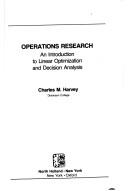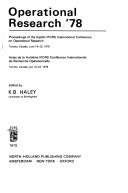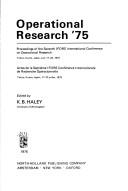| Listing 1 - 10 of 815 | << page >> |
Sort by
|

ISBN: 0444003002 9780444003003 Year: 1979 Publisher: New York (N.Y.): North-Holland,
Abstract | Keywords | Export | Availability | Bookmark
 Loading...
Loading...Choose an application
- Reference Manager
- EndNote
- RefWorks (Direct export to RefWorks)
Book
ISBN: 270570311X 9782705703110 Year: 1979 Publisher: Paris: Hommes et techniques,
Abstract | Keywords | Export | Availability | Bookmark
 Loading...
Loading...Choose an application
- Reference Manager
- EndNote
- RefWorks (Direct export to RefWorks)
Book
ISBN: 1527530450 9781527530454 Year: 2019 Publisher: Newcastle upon Tyne
Abstract | Keywords | Export | Availability | Bookmark
 Loading...
Loading...Choose an application
- Reference Manager
- EndNote
- RefWorks (Direct export to RefWorks)
The behavior of any real system is a process to a greater or lesser degree probabilistic. As a rule, it is impossible to specify exactly which external influences and internal mechanisms of interaction of the system components will be decisive in the future. As a consequence, we cannot accurately predict the behavior of the system. We can only talk about the probability that, in the future, the system will come to a particular state. While the problem of the probabilistic description of all possible future states of the system is very difficult to answer, it is often enough, for research purposes, to obtain answers to questions that are more simple, for example, "For how long will, on average, the system operate in a given mode?" or "What is the probability that the process of functioning of the system will come out of given mode to a specific point in time?" Problems of this type concern the crossings of a level by a random process.This book states some of the most important fundamental results related to crossings problems. The known problem of first reaching boundaries by a random process is discussed in detail. It explores the solution of this problem for arbitrary continuous processes, and also considers the application of obtained mathematical results to the investigation of the safety of an airplane landing.The book will appeal to engineers and scientists who are interested in the applications of random processes theory and its methods. Its results will also be of interest for mathematicians who study crossings problems.
Book
ISBN: 1527548953 1527547922 9781527548954 9781527547926 Year: 2020 Publisher: Newcastle upon Tyne
Abstract | Keywords | Export | Availability | Bookmark
 Loading...
Loading...Choose an application
- Reference Manager
- EndNote
- RefWorks (Direct export to RefWorks)
Book
ISBN: 3736980353 9783736980358 9783736990357 Year: 2015 Publisher: Göttingen Cuvillier Verlag
Abstract | Keywords | Export | Availability | Bookmark
 Loading...
Loading...Choose an application
- Reference Manager
- EndNote
- RefWorks (Direct export to RefWorks)

ISBN: 0444852301 9780444852304 Year: 1979 Publisher: Amsterdam: North-Holland,
Abstract | Keywords | Export | Availability | Bookmark
 Loading...
Loading...Choose an application
- Reference Manager
- EndNote
- RefWorks (Direct export to RefWorks)
OPERATIONS RESEARCH --- congresses --- Operations research --- Recherche opérationnelle --- Operations research - Congresses

ISBN: 0720403847 9780720403848 Year: 1976 Publisher: Amsterdam: North-Holland,
Abstract | Keywords | Export | Availability | Bookmark
 Loading...
Loading...Choose an application
- Reference Manager
- EndNote
- RefWorks (Direct export to RefWorks)
Planning (firm) --- OPERATIONS RESEARCH --- congresses --- Operations research --- Operations research - Congresses
Book
ISBN: 9783031810688 3031810686 Year: 2025 Publisher: Cham : Springer Nature Switzerland : Imprint: Palgrave Macmillan,
Abstract | Keywords | Export | Availability | Bookmark
 Loading...
Loading...Choose an application
- Reference Manager
- EndNote
- RefWorks (Direct export to RefWorks)
This book offers a comprehensive and interdisciplinary approach to decision-making, synthesizing perspectives from psychology, business strategy, and system dynamics. Integrating real-world examples with structured decision-making frameworks, it makes complex concepts accessible and practical. The text uniquely bridges personal and professional decision-making, demonstrating their interconnectedness and the universal applicability of sound decision-making principles. Positioned within the literature on cognitive psychology, behavioral economics, and business management, it engages with ongoing debates on the role of cognitive biases, emotional influences, and the importance of structured decision-making processes in achieving sustainable outcomes. Hassan Qudrat-Ullah is a professor of decision sciences with the School of Administrative Studies at York University, Toronto, Canada. Hassan has over 20 years of teaching, research, industry, and consulting experience in the USA, Canada, Singapore, Norway, UK, Korea, China, Saudi Arabia, Latvia, Switzerland, Spain, and Pakistan. He is a well-known scholar in decision sciences, energy policy modeling, and system dynamics areas. He has authored and edited over 150 refereed publications including 23 books (including edited volumes), 43 journal articles, and numerous conference proceedings and presentations. In 2017, he won York University's Faculty of Liberal Arts and Professional Studies' Excellence in Research Award.
Book
ISBN: 9783031096075 Year: 2022 Publisher: Cham Springer International Publishing :Imprint: Springer
Abstract | Keywords | Export | Availability | Bookmark
 Loading...
Loading...Choose an application
- Reference Manager
- EndNote
- RefWorks (Direct export to RefWorks)
Book
ISBN: 0309210968 1283044579 9786613044570 0309158567 9780309158565 9781283044578 0309158559 9780309158558 Year: 2011 Publisher: Washington, D.C. National Academies Press
Abstract | Keywords | Export | Availability | Bookmark
 Loading...
Loading...Choose an application
- Reference Manager
- EndNote
- RefWorks (Direct export to RefWorks)
When you purchase a product, you expect it to work. Construction workers on high-rise buildings need to be confident that their safety harnesses will arrest a fall. Firefighters need to know that their gloves and other protective equipment can withstand high temperatures. Healthcare workers administering highly toxic chemotherapy agents need to know that their gloves will withstand penetration. For personal protective technologies (PPT)--where the major purpose of the product is to protect the wearer against a hazard--a deficit in product effectiveness can mean injury, illness, or death. Examining the extent to which products meet specific performance or design criteria is the focus of conformity assessment efforts. For PPT conformity assessment, the ultimate goal is preventing worker illness, injury, or death from hazardous working conditions. This book focuses on conformity assessment for occupational PPT--ensuring that PPT are effective in preventing or reducing hazardous exposures or situations that workers face in their jobs. Because respirators already have an extensive testing and conformity assessment process in place, this book specifically addresses conformity assessment processes for other types of PPT, including eye and face protection, gloves, hearing protectors, and protective clothing.--Publisher's description.
| Listing 1 - 10 of 815 | << page >> |
Sort by
|

 Search
Search Feedback
Feedback About UniCat
About UniCat  Help
Help News
News